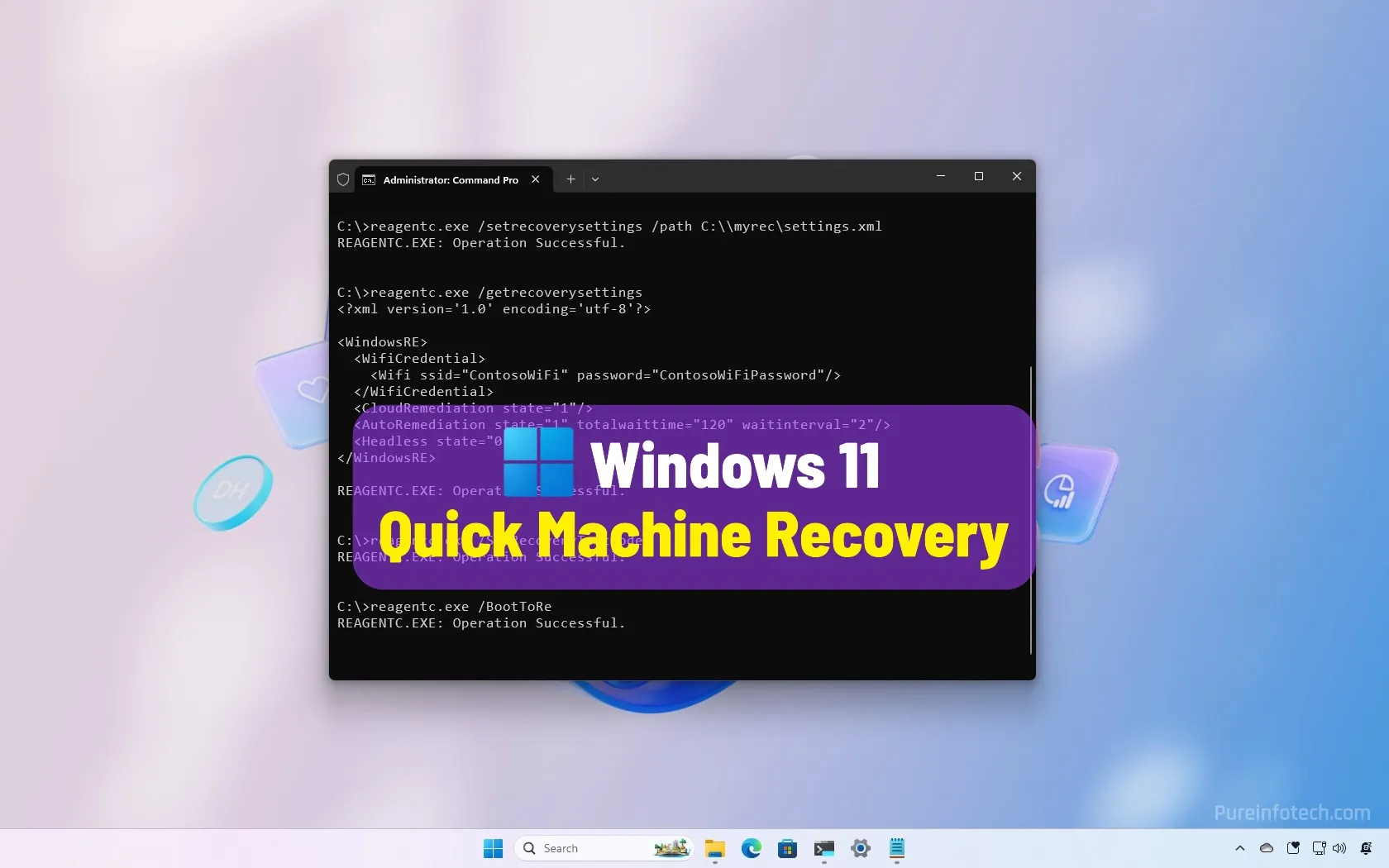On Windows 11, you can now use the Quick Machine Recovery (QMR) feature to fix your computer when it can’t boot correctly, and in this guide, I’ll show you how the feature works and how to configure it.
The feature is built into the operating system and designed for seamless recovery. This isn’t your standard Safe Mode or Startup Repair. It’s a new recovery mechanism that brings your computer back online when there’s a critical problem with the boot process.
While an individual user facing boot issues might have the time, these problems become a nightmare for network administrators when critical errors (like the Blue Screen of Death) render a whole fleet of devices unbootable. This isn’t hypothetical – the widespread disruption following the CrowdStrike update incident demonstrated this exact challenge… To address this type of incident, Microsoft includes “Quick Machine Recovery” within the Windows Recovery Environment (WinRE) to speed up recovery at a large scale without reinstalling Windows or losing your files.
What’s Quick Machine Recovery for Windows 11?
Quick Machine Recovery is a new feature that aims to reduce downtime due to a boot failure by automatically detecting and fixing boot issues using WinRE and Windows Update.
When a critical failure happens, the system will automatically connect to the internet and upload the diagnostic information to Microsoft, and then the device will receive targeted fixes.
An internal response team is activated to develop, validate, and prepare a targeted remediation if a widespread outage is detected.
Currently, this feature is available in the Beta Channel for version 24H2, and it’s unclear when the company will roll it out to everyone.
How is QMR configured on Windows 11 Home and Pro?
On Windows 11 Home, cloud remediation is turned on by default, while auto-remediation is turned off by default.
On the other hand, on Windows 11 Pro, cloud remediation and auto-remediation are turned off by default.
Cloud remediation is the process of using “Windows Update” to find fixes for issues on your computer.
If the feature is enabled, the computer will connect to the internet and use the Windows 11 update system during recovery.
Auto-remediation allows you to automate the recovery process. If the feature is enabled, the computer will connect automatically to “Windows Update” and try to find a remediation.
If the system can’t find a solution on the first attempt, it retries without manual intervention.
If the feature is disabled or not configured, the computer requires manual user interaction to continue the recovery process.
However, here’s the caveat. Quick machine recovery is a best-effort feature. It might not always be possible to find a solution for every issue.
How does Quick Machine Recovery work on Windows 11?
This is how the recovery process is when Quick Machine Recovery is enabled on the computer.
- Device crash: When the device fails to boot multiple times, the system automatically detects an issue and starts the recovery process.
- Boot to recovery: The computer boots into the Windows Recovery Environment, and the QMR process begins.
- Network connection: After a network connection is established, the computer scans Windows Update for fixes.
- Remediation: If a solution is found, the computer will download and apply it. If no solution is found, the system retries the process based on the configured retry scanning intervals and time-outs.
- Reboot: After the remediation is applied, the computer reboots, and if the solution is successful, it’ll boot into the desktop environment. If the solution fails, the device reboots into WinRE again, and the process repeats in step 2.
Configure Quick Machine Recovery on Windows 11
To configure the Quick Machine Recovery feature on Windows 11 Pro, follow these steps:
-
Open Start on Windows 11.
-
Search for Notepad and click the top result to open the app.
-
Compose the following content in XML format:
-
Confirm the wireless SSID and password in the “Wifi” settings to allow the device to connect to the network.
Quick tip: If the device is using an Ethernet network, you don’t have to configure this setting.
-
Set the state value of CloudRemediation to 1 to enable the feature.
-
Set the state value of AutoRemediation to 1 to enable the feature.
-
Choose the value (in minutes) for the “totalwaittime” setting (for example, 120) to specify how long the system should wait before rebooting.
-
Choose the value (in minutes) for the “waitinterval” setting (for example, 2) to specify when the system should check for remediations.
-
Open the File menu and choose the Save As option.
-
Save the file as the settings.xml file on your computer.
-
Open Start.
-
Search for Command Prompt (or Terminal), right-click the top result, and choose the Run as administrator option.
-
(Optional) Type this command to check the current configuration and press Enter:
reagentc.exe /getrecoverysettings
-
Type this command to enable the Quick Machine Recovery feature and press Enter:
reagentc.exe /setrecoverysettings /path C:\\myrec\settings.xml
In the command, update the path of the XML file to match the location you are using.
-
Type this command to check the new configuration and press Enter:
reagentc.exe /getrecoverysettings
-
(Optional) Type this command to enable the QMR test mode and press Enter:
reagentc.exe /SetRecoveryTestmode
-
(Optional) Type this command to set your device to launch WinRE upon reboot and press Enter:
reagentc.exe /BootToRe
As part of the configuration, you have created and applied the configuration file to enable Quick Machine Recovery on Windows 11. If you’re using the same settings as I did, the system will wait 2 hours before rebooting and check for remediation every 2 minutes.
You can always remove and clear the settings by running the reagentc.exe /clearrecoverysettings
command.
Source link
